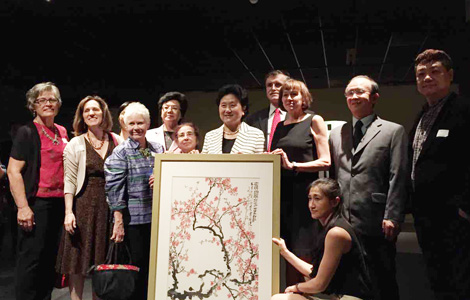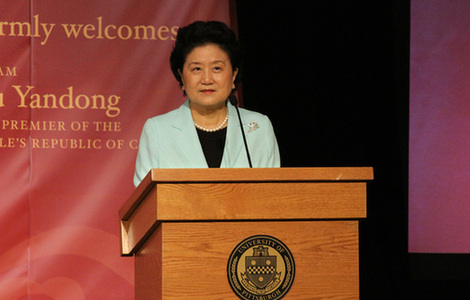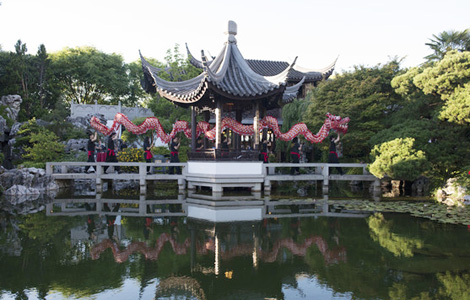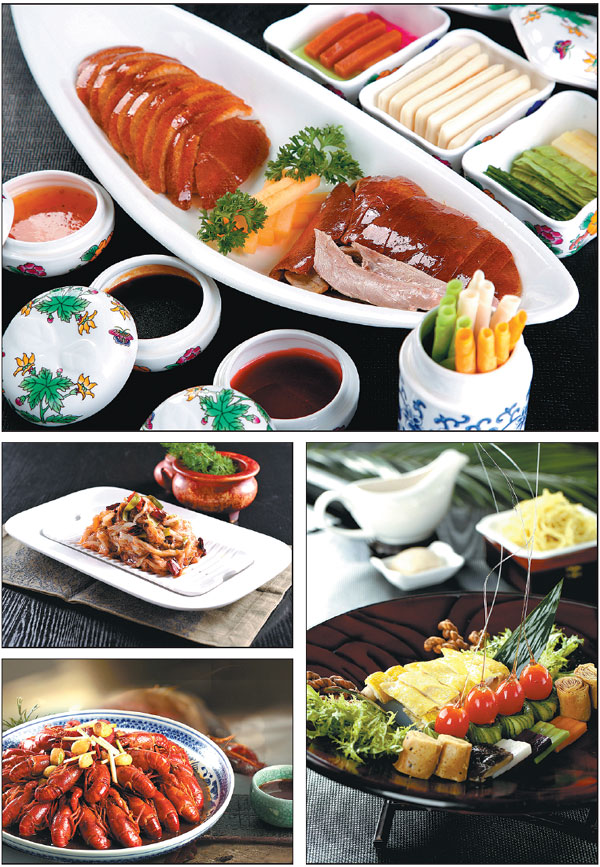Of cabbages and kings
Updated: 2015-06-23 07:30
By Liu Zhihua(China Daily USA)
|
|||||||||
Hua's Garden does Beijing classics with flair, from humble cabbages to the king of dishes in the capital, Peking duck. Liu Zhihua reports.
To rate a cook, many Chinese people believe you simply have to ask the cook to stir-fry Chinese cabbage. The household dish is easy to prepare, but difficult to make delicious and present beautifully.
It poses little challenge, however, at Hua's Garden, an established fine-dining restaurant group famous for old Beijing flavor - and one of the best places to eat fried Chinese cabbage.
|
Clockwise from top: Hua's Garden's version of Peking roast duck, the restaurant's popular "Yiyuan" chicken, a classic crawfish dish and fried Chinese cabbage. Photos Provided to China Daily |
Founded in 1998 by a Beijing native surnamed Hua, the company now boasts 13 branches in the capital. We recently visited one of its flagship restaurants, in the Wangfujing area, which is decorated in traditional Beijing style, with charming Chinese lanterns dangling from wooden eaves, radiating light on wooden tables and velvet-covered chairs.
Hua's cabbage is among the group's signature dishes and a hit with both locals and foreign diners, according to Fu Tao, a publicity executive with the company.
Fu says only the best part of fresh cabbage leaves are used, following a secret recipe that includes myriad seasonings, precisely measured. The leaves are not knife-cut, but hand-shredded.
The resulting flavor is light but tasty, well-balanced between spicy and sour with an edge of sweetness.
In a Beijing-styled restaurant, Peking roast duck is inevitable, and the bird on offer at Hua's Garden is dazzling.
The founder discovered the recipe in an ancient book and then got creative.
Every bird is of similar size so that all are roasted over the date-wood fire at a similar rate. As the fragrant smoke is absorbed, the ducks' marinade is infused into the crisp coating and meltingly tender meat, Fu says.
Our duck had an attractively dark, date-red color. Wrapping the juicy meat, crispy skin with the salty-sweet bean paste and cucumbers in the light pancakes creates a delicious chemistry. Unless a customer asks for spring onion, that traditional ingredient is not served - an innovation by omission designed to avoid bad breath after the meal. Other goodies can be slipped into the rolled pancake with the duck, including shredded lettuce and julienne of pineapple, hami melon, and hawthorn cake.
Summertime diners at the restaurant won't want to miss the crawfish, a specialty offered now at the peak harvest time.
The restaurant group has a crawfish production base near Beijing, a few hours' drive away, to ensure the freshness of the freshwater crustaceans. Almost half of the "Chinese lobsters" cooked in the group's kitchens are from the base, and the rest are from Xuyi county, Huai'an city in Jiangsu province, famous for having some of the best crawfish in China.
Publicist Fu says Hua's Garden was among the first restaurants to introduce crawfish to Beijing menus back in the 1990s at its eatery in Guijie food street, otherwise known as Ghost Street.
The restaurant has developed dozens of crawfish dishes over time, but the classics on the menu are dishes made with ground garlic, chilies, salty water, or stir-fried. There are also Korean kimchi-flavored, super spicy and milk-flavored crawfish dishes, which are very popular among young people, Fu says.
We opted for the traditional garlic flavor. The process of eating crawfish is half the fun, working at the shell to get to the tastiest morsels. Sometimes a broken, sharp shell may seem threatening, but Hua's servers are ready to help diners pick out the delicious bits of meat.

We also liked the restaurant's popular "Yiyuan" chicken, a cold dish created in the 1990s for Anita Mui Yim-fong, a famous Hong Kong singer and actress, who died in 2003.
The generously portioned dish consists of chicken meat, noodles, rice jelly, mushrooms, and tomatoes dipped in spun sugar - each tipped with a long decorative spike that demanded careful eating. The platter also included a vegetable salad of cucumber, black fungus, purple cabbage and more, plus traditional Beijing snacks such as mahua (twists of fried dough).
Eaten with the restaurant's house-made spicy sauce, the dish had a rich mix of flavors and textures. The restaurant's attention to detail is also impressive: It offers fresh pear slices after dinner to freshen breath. Dinners can also ask for non-spicy sauce.
Contact the writer at liuzhihua@chinadaily.com.cn
(China Daily USA 06/23/2015 page9)

 Liu visits Houston Museum of Natural Science
Liu visits Houston Museum of Natural Science
 Liu meets Tsinghua Youth team in Houston
Liu meets Tsinghua Youth team in Houston
 Men get into women's shoes for fun
Men get into women's shoes for fun
 Millions in harmony on Yoga Day
Millions in harmony on Yoga Day
 Liu visits CI in Pittsburgh
Liu visits CI in Pittsburgh
 Shenzhen Maker Week kicks off
Shenzhen Maker Week kicks off
 Chinese wrap up Zongzi to mark upcoming Dragon Boat Festival
Chinese wrap up Zongzi to mark upcoming Dragon Boat Festival
 A Chinese Garden in a Sister City
A Chinese Garden in a Sister City
Most Viewed
Editor's Picks

|

|

|

|

|

|
Today's Top News
Liu Yandong plays basketball diplomacy
Wang Yang hails S&ED
Tsinghua students flying high
Official underlines national defense technology innovation
New anti-corruption app sparks instant flood of public reports
Chinese Premier emboldens state firms' int'l industrial cooperation
CI in Pittsburgh welcomes
vice-premier
Sichuan and Pittsburgh unveil
new school
US Weekly

|

|








